#World Honey Bee Day
Explore tagged Tumblr posts
Text
For #WorldHoneyBeeDay 🍯🐝:

Perfume Bottle, c.1893Designed by Paulding Farnham (USA, 1859-1927) for Tiffany & Co.
Gold, agate, yellow sapphires, demantoid garnets, red garnets, amethyst
3 5/8 x 1 7/8 x 1 7/8 in., 212.9 Grams (9.2 x 4.8 x 4.8 cm, 6.845 Troy Ounces)
Metropolitan Museum of Art, New York 65.143
“The agate body of this perfume bottle was carved to resemble honeycomb, while the gold and silver ornament depicting bees and honeysuckle flowers continues the theme. Originally, a conical yellow sapphire adorned the top of the lid. The report by the French ministry of commerce on Tiffany’s display at the 1893 World’s Columbian Exposition in Chicago highlighted this bottle as a particularly fine and original example of the firm’s oeuvre.”
#animals in art#animal holiday#19th century art#bee#honey bee#honeybee#honeycomb#insect#World Honey Bee Day#Art Nouveau#American art#decorative arts#perfume bottle#Tiffany & Co#Metropolitan Museum of Art New York#Paulding Farnham#previous stones#gemstones
36 notes
·
View notes
Text

#honeybee#honeybeeday#veganism#vegetarian#vegan#bee#save the bees#bees#world honey bee day#worldhoneybeeday#animals lovers#antispeciesism#anti capitalism#govegan#plantbased
9 notes
·
View notes
Text












World Honey Bee Day
These little creatures are nature's buzzworthy superstars! They're responsible for pollinating a third of our food supply and creating delicious honey.
We often take nature for granted. We don’t think about the pivotal role that all of life’s creatures play. However, World Honey Bee Day gives you the perfect opportunity to pay honor to the incredible honey bee. Read on to discover everything you need to know about this day, as well as the critical role that honey bees play in our everyday lives.
Learn about World Honey Bee Day
World Honey Bee Day is an awareness day whereby honey bee enthusiasts, beekeeping associations and clubs, and beekeepers celebrate the honey bee. It is a day to recognize the contribution that honey bees make to our everyday lives, as well as learning about the different steps that we can take in order to protect this vital species. On World Honey Bee Day, we also pay homage to beekeepers. After all, it is their efforts that make sure that there are healthy and well-managed bees to pollinate crops.
The health benefits of honey
Of course, honey bees provide us with honey, and this is one of the many reasons why we should be thankful for them! Honey is a golden, thick liquid, which is produced by bees using the nectar of plants that are flowering. The kind of flowers that bees visit will impact the texture, smell, and taste of the honey, resulting in different types of honey, including orange blossom, clover, acacia, and manuka honey.
There are a lot of nutritional benefits that are associated with adding a bit of honey to your diet. High-quality honey offers a number of benefits because of the antioxidants that are included. These include phenolic compounds, such as flavonoids, as well as organic acids. The antioxidants that are found in honey have been linked to lowering the risk of strokes, heart attacks, and some forms of cancer. They are also believed to assist in terms of eye health.
There have also been studies that have shown that honey can help to improve your cholesterol levels. If you have high LDL cholesterol levels, then you are going to be at a greater risk of having heart disease. This sort of cholesterol plays a massive role in atherosclerosis, which is the fatty buildup in your arteries that can cause strokes and heart attacks as well. There are more and more studies that are showing that honey can help to enhance your cholesterol levels. This is because it significantly raises the good HDL cholesterol while lowering the total of bad LDL cholesterol.
Honey cannot only benefit you in terms of consuming it, but it has been used for many years as a topical treatment for healing burns and wounds. In fact, this can be dated back to Ancient Egypt. Researchers have concluded that the healing powers of honey come from the anti-inflammatory and antibacterial effects it has, as well as its ability to nourish the tissue that surrounds the wounded area.
Bees are disappearing
Bees are critical to our daily living, yet they are in decline on a worldwide scale. This is because they face a number of different threats. The use of toxic pesticides is one of these threats. They are also at risk due to habitat loss, as there has been an increase in invasive farming methods and urban developments, meaning that places that honey bees used to call home do not exist anymore. In honor of World Honey Bee Day, it is good to do your bit in order to raise awareness regarding the risks that honey bees all around the world face and the steps that we can take in order to help them. You can begin by researching this issue so that you can find more information about the different challenges that bees face and the reasons why their population is on the decline. By doing this, you will then be able to educate others and we can all do our bit to make sure that the number of bees starts to increase again, rather than decline.
History of World Honey Bee Day
World Honey Bee Day, previously known as Honey Bee Awareness Day, is an idea put together by beekeepers in the USA, who petitioned the USDA in 2009 for an official day to honor honey bees and beekeeping. A few years down the line, people across the globe are holding a date of observation every year.
The organizers of the event, on the concept of the World Honey Bee Day, have said:
Bring together beekeepers, bee associations, as well as other interested groups to connect with the communities to advance beekeeping. By working together and harnessing the efforts that so many already accomplish, and [by] using a united effort one day a year, the rewards and message is magnified many times over. We encourage bee associations, individuals, and other groups to get involved. The program is free and open to all.
How to celebrate World Honey Bee Day
Honey Bee awareness enthusiasts will likely put a bee in your bonnet and say this is not so much a day to celebrate honey bees, as it is to promote their involvement in sustainable farming.
On this day, bee lovers everywhere decorate their gardens with lavender, borage, and marjoram, the bee’s knees in pollinator lures. If you have the time and patience, bake some honey chippers and make your own honey fruit cobbler.
We also recommend that you take the time to learn more about the honey bee on this day and how we can all do our bit in order to provide them with a supportive environment. When we plant orchards, wildflowers, and other types of flowering plants, we are supporting pollinators, which includes honey bees. Honey bees depend on the nectar of different plants in order to survive. We also need to recognize that we depend on honey bees for our own survival. After all, if they did not pollinate, a lot of the nutritious plants that we need would not reproduce. It’s all about the circle of life, and we should do our bit to help other specious along the way.
Another way to celebrate World Honey Bee Day is by enjoying a honey-based treat. There are lots of different options for you to choose from. Whether you’re looking for a tasty dessert or you want to incorporate honey into your main meal, we have got you covered. Here are some tasty suggestions to consider: honey-roast confit of duck, honey cake, vanilla and honey madeleines, stir-fried pork with honey and ginger, salted honey fudge and chocolate tart, honey mustard grilled salmon, homemade crumpets with burnt honey butter, and crispy honey buffalo wings. Is your mouth watering yet?
And because you’ve been as busy as a bee all day, sit back and watch Hitchcock’s ‘The Bees’. You’ll count your blessings honey bees are nothing like South American killer bees!
Source
#Damariscotta Shell Midden Historic District#Purple Haze Organic Lavender Farm#Tyresö#World Honey Bee Day#USA#Sweden#travel#vacation#original photography#fauna#flora#nature#wildlife#insect#animal#WorldHoneyBeeDay#other insects too#Brix Restaurant & Gardens#Turnbull Wine Cellars#flower#third Saturday in August#17 August 2024
4 notes
·
View notes
Text
Happy World Honey Bee Day 2023!

Happy World Honey Bee Day 2023 (May 20th)! Save and support these wonderful animals, they work hard for our planet :)
World Bee Day has been celebrated on 20 May since 2018. On this day in 1734, Anton Janša was born and is considered a pioneer of modern beekeeping. The commemoration day was proposed by Slovenia within the United Nations Organisation and adopted on 20 December 2017. In 2019, 15 official events were held across three continents. An International Round Table was held in Rome.
The aim of World Bee Day is to highlight the immense importance of bees to a broad public. Due to their indispensable pollination service, they promote biological biodiversity and food security for humans, but also for animals. Furthermore, this commemorative day is intended to draw attention to the sharp decline in the bee population and the need to protect these insects.
Bees are known for their role in pollination and honey bees are also known for the production of honey and other bee products. Besides the honey bee, there are about 30,000 species of wild bees worldwide. Of these, 548, a good 550, or even 574 species live in Germany, depending on experts, year of publication and species concept used, of which almost half are considered threatened.
Source: German Wikipedia, Translation mine. Picture by Ottó auf Pixabay
8 notes
·
View notes
Text

Today is National Honey Bee Day! And to celebrate, I had Amethyst... uh...
Okay, so... I'm gonna need to explain what's going on here...
For those not in the know, the only bees and wasps that can sting are the females. Their stingers contain a lethal substance known as venom.
Whenever someone transforms into a female bee or wasp, their abdomen will rapidly begin filling with venom, with something known as a venom sac forming around the substance.
However, the sac will become so full of venom in the process, that it will cause the individual's newly-formed venom pumps to begin automatically reacting, in order to remove some of the venom and give the sac some breathing room.
The pressure thrown onto the individual as a result of this will give them an urge to release their stinger from its sheath. Once this happens, the stinger will begin to release spurts of venom, the amount ranging from medium-sized to rather big.
The expulsion of venom can often be even more intense if the TF process involves a male becoming a female bee or wasp.
This process is known among bees and wasps as "poisoned orgasms" (even though poison isn't the same as venom but whatever), since the process results in individuals becoming rather horny during it (some have even climaxed for real as a result).
#cw: kinda gross#amethyst's august#transformation#overweight#amethyst#national honey bee day#world honey bee day
1 note
·
View note
Text
Lets Cultivate Bee Friendly Habits
World Honey Bee Day, also known as World Bee Day, is an annual observance that celebrates the importance of honey bees and other pollinators to our ecosystems, agriculture, and food production. It is typically held on the third Saturday of August each year. This year it is on 19th August 2023. The day aims to raise awareness about the critical role that bees play in sustaining life on Earth and…

View On WordPress
0 notes
Text
I finally took the plunge and started reading my first longform (longer than 5 or so chapters) fanfic and I’m having a lovely time. But genuinely… HOW DO YOU PEOPLE COPE? ONE OF THE TWO MAIN CHARACTERS JUST DIED AND THE OTHER HAS BEEN TOTALLY STRIPPED OF THIER BODY… AND THERE ARE SOMEHOW TEN MORE CHAPTERS LEFT?!?
HOW DO PEOPLE READ MULTIPLE OF THESE, MY ENTIRE WAKING MIND IS TAKEN OVER BY WANTING TO READ MORE OF THIS BUT IT’S 3 AM AND I HAVE TO GET TO BED AAAAAA
#Anyway go read Iron Oxide by TheEnigmaMachine because it has completly rewired my brain chemistry#Also it somehow mixes in fun physics based world building… so that’s fun in the moments where my heart isn’t being ripped to shreds! :]#metonic#iron oxide#fanfic spoilers#I guess but it’s like… nearly a decade old#God Sonic girl you are going through it huh?#I though Archie put you through the wringer but honey… you’re going through some Charmy Bee level trauma.#You’re going through some Jesus Bible level trauma#Anyway now hurry up and find a way to revive your robot boyfriend my heart can’t take anymore good lord.#Also hi loyal tag reader. Go listen to Brothertiger’s self titled album. I spend all day daydreaming about Metonic listening to it on loop
12 notes
·
View notes
Text







Repost @baytal.fann
"In the Holy Qur’an a chapter is dedicated to the bee, called An-Nahl. This literally translates to ‘The Bee’ & it describes the bee’s way of life, & how Muslims should be more like them.
For World Bee Day we are celebrating the bee in Islam 🐝
Al Nahl, Chapter 16, 68-69, talks about a variety of topics, but Allah specifically chose the title The Bee to catch the attention of the readers. Bees are said to be Allah’s miracles; the way they function and how they behave, are to be held as an example.
The significance of Al Nahl as Chapter 16 is important. The only verse in this chapter that mentions bees is made up of 16 words & 16 different Arabic letters. Coincidentally, female bees have 16 pairs of chromosomes, whereas males have 16 chromosomes.
What is fascinating about the bees in the Qur’an is that it was written from a scientific standpoint where the colony, roles, and practices of bees are observed. These characteristics & traits were used as a figure of speech for the follower reading the Qur’an.
A reason why an entire chapter in the Qur’an has been devoted to the bee is that Allah has enabled the honey bee to produce a substance within which there is a cure for all mankind. Honey!
Bees live less than 40 days, visit at least 1000 flowers & produces less than a teaspoon of honey. For us it is only a teaspoon of honey, but for the bee it is a lifetime of work.
Thank You Bees!
Beautiful art by @lucythomasinmorrish please do check out her incredible paintings."
13 notes
·
View notes
Text
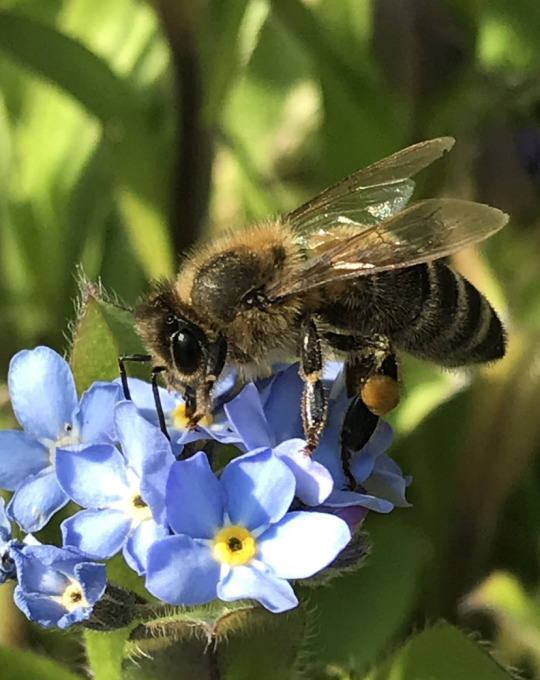
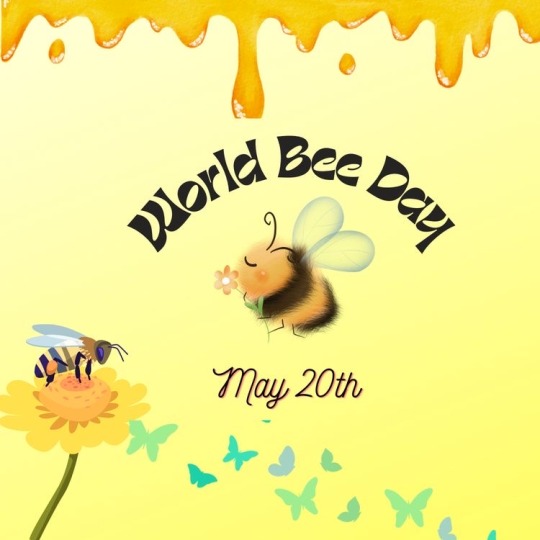
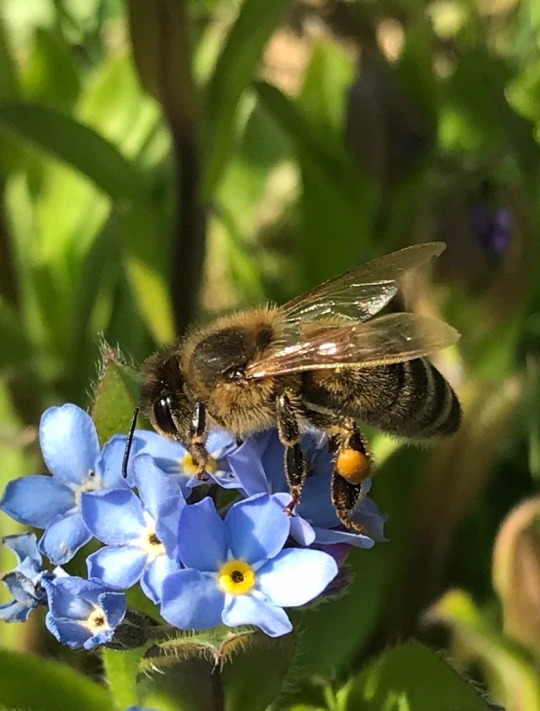
#HAPPY💙WORLD🌍BEE DAY
🐝🤎🐝
@samirafee
#source: samirafee#own picture#own pictures#photographers on tumblr#nature#insects#honey bee#my garden#world bee day#may 20th#quote by unknown source#may 2023
46 notes
·
View notes
Text
For #WorldHoneyBeeDay 🍯🐝:

Beehive with Blackberry Branches (Cheese Stand)
Minton & Co., design registered 1862
glazed earthenware (majolica)
(Photographed at the Majolica Mania exhibition the Walters Art Museum in 2022.)
#animals in art#animal holiday#european art#19th century art#majolica#museum visit#exhibition#pottery#ceramics#beehive#World Honey Bee Day#cheese stand#Walters Art Museum#British art#Minton & Co.
17 notes
·
View notes
Text

Some bees for bee day.
6 notes
·
View notes
Text
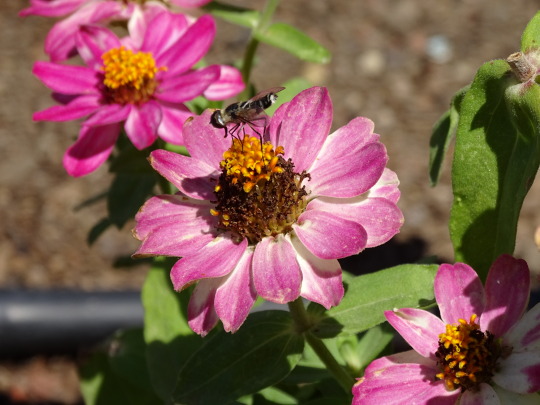
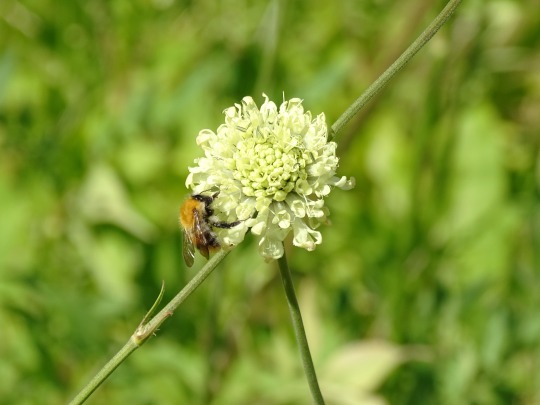

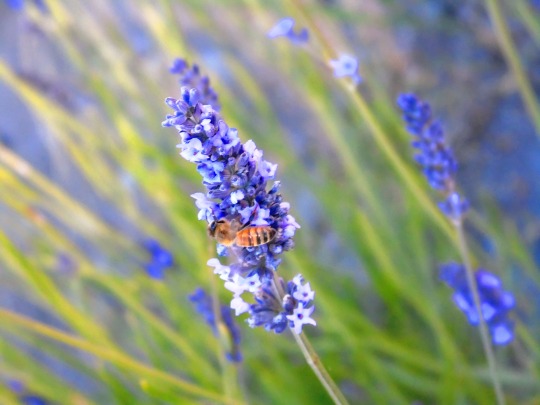





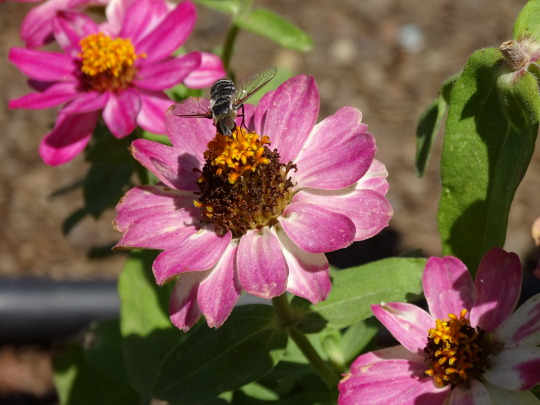
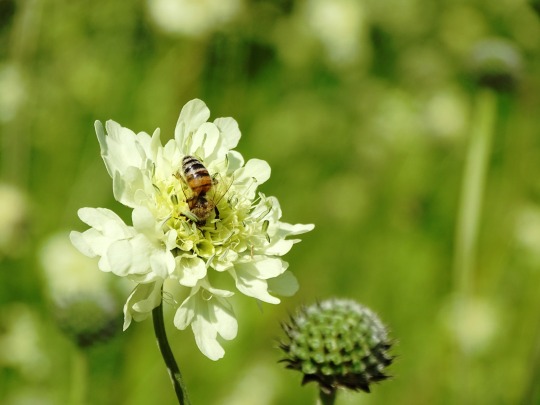
World Honey Bee Day
These little creatures are nature's buzzworthy superstars! They're responsible for pollinating a third of our food supply and creating delicious honey.
We often take nature for granted. We don’t think about the pivotal role that all of life’s creatures play. However, World Honey Bee Day gives you the perfect opportunity to pay honor to the incredible honey bee. Read on to discover everything you need to know about this day, as well as the critical role that honey bees play in our everyday lives.
Learn about World Honey Bee Day
World Honey Bee Day is an awareness day whereby honey bee enthusiasts, beekeeping associations and clubs, and beekeepers celebrate the honey bee. It is a day to recognize the contribution that honey bees make to our everyday lives, as well as learning about the different steps that we can take in order to protect this vital species. On World Honey Bee Day, we also pay homage to beekeepers. After all, it is their efforts that make sure that there are healthy and well-managed bees to pollinate crops.
The health benefits of honey
Of course, honey bees provide us with honey, and this is one of the many reasons why we should be thankful for them! Honey is a golden, thick liquid, which is produced by bees using the nectar of plants that are flowering. The kind of flowers that bees visit will impact the texture, smell, and taste of the honey, resulting in different types of honey, including orange blossom, clover, acacia, and manuka honey.
There are a lot of nutritional benefits that are associated with adding a bit of honey to your diet. High-quality honey offers a number of benefits because of the antioxidants that are included. These include phenolic compounds, such as flavonoids, as well as organic acids. The antioxidants that are found in honey have been linked to lowering the risk of strokes, heart attacks, and some forms of cancer. They are also believed to assist in terms of eye health.
There have also been studies that have shown that honey can help to improve your cholesterol levels. If you have high LDL cholesterol levels, then you are going to be at a greater risk of having heart disease. This sort of cholesterol plays a massive role in atherosclerosis, which is the fatty buildup in your arteries that can cause strokes and heart attacks as well. There are more and more studies that are showing that honey can help to enhance your cholesterol levels. This is because it significantly raises the good HDL cholesterol while lowering the total of bad LDL cholesterol.
Honey cannot only benefit you in terms of consuming it, but it has been used for many years as a topical treatment for healing burns and wounds. In fact, this can be dated back to Ancient Egypt. Researchers have concluded that the healing powers of honey come from the anti-inflammatory and antibacterial effects it has, as well as its ability to nourish the tissue that surrounds the wounded area.
Bees are disappearing
Bees are critical to our daily living, yet they are in decline on a worldwide scale. This is because they face a number of different threats. The use of toxic pesticides is one of these threats. They are also at risk due to habitat loss, as there has been an increase in invasive farming methods and urban developments, meaning that places that honey bees used to call home do not exist anymore. In honor of World Honey Bee Day, it is good to do your bit in order to raise awareness regarding the risks that honey bees all around the world face and the steps that we can take in order to help them. You can begin by researching this issue so that you can find more information about the different challenges that bees face and the reasons why their population is on the decline. By doing this, you will then be able to educate others and we can all do our bit to make sure that the number of bees starts to increase again, rather than decline.
History of World Honey Bee Day
World Honey Bee Day, previously known as Honey Bee Awareness Day, is an idea put together by beekeepers in the USA, who petitioned the USDA in 2009 for an official day to honor honey bees and beekeeping. A few years down the line, people across the globe are holding a date of observation every year.
The organizers of the event, on the concept of the World Honey Bee Day, have said:
Bring together beekeepers, bee associations, as well as other interested groups to connect with the communities to advance beekeeping. By working together and harnessing the efforts that so many already accomplish, and [by] using a united effort one day a year, the rewards and message is magnified many times over. We encourage bee associations, individuals, and other groups to get involved. The program is free and open to all.
How to celebrate World Honey Bee Day
Honey Bee awareness enthusiasts will likely put a bee in your bonnet and say this is not so much a day to celebrate honey bees, as it is to promote their involvement in sustainable farming.
On this day, bee lovers everywhere decorate their gardens with lavender, borage, and marjoram, the bee’s knees in pollinator lures. If you have the time and patience, bake some honey chippers and make your own honey fruit cobbler.
We also recommend that you take the time to learn more about the honey bee on this day and how we can all do our bit in order to provide them with a supportive environment. When we plant orchards, wildflowers, and other types of flowering plants, we are supporting pollinators, which includes honey bees. Honey bees depend on the nectar of different plants in order to survive. We also need to recognize that we depend on honey bees for our own survival. After all, if they did not pollinate, a lot of the nutritious plants that we need would not reproduce. It’s all about the circle of life, and we should do our bit to help other specious along the way.
Another way to celebrate World Honey Bee Day is by enjoying a honey-based treat. There are lots of different options for you to choose from. Whether you’re looking for a tasty dessert or you want to incorporate honey into your main meal, we have got you covered. Here are some tasty suggestions to consider: honey-roast confit of duck, honey cake, vanilla and honey madeleines, stir-fried pork with honey and ginger, salted honey fudge and chocolate tart, honey mustard grilled salmon, homemade crumpets with burnt honey butter, and crispy honey buffalo wings. Is your mouth watering yet?
And because you’ve been as busy as a bee all day, sit back and watch Hitchcock’s ‘The Bees’. You’ll count your blessings honey bees are nothing like South American killer bees!
Source
#Damariscotta Shell Midden Historic District#Purple Haze Organic Lavender Farm#Tyresö#World Honey Bee Day#USA#Sweden#travel#vacation#original photography#fauna#flora#nature#wildlife#insect#animal#WorldHoneyBeeDay#other insects too#Brix Restaurant & Gardens#Turnbull Wine Cellars#flower#third Saturday in August#19 August 2023
2 notes
·
View notes
Text
08/17/2024 is International Geocaching Day 🌎, World Day of Homeless Animals 🌎, National Heritage Week 🇮🇪, Prekmurje Reunification Day 🇸🇮, National Thrift Shop Appreciation Day 🇺🇸, Black Cat Appreciation Day 🐈⬛️🇺🇸, National Honey Bee Day 🐝🇺🇸, Cupcake Day 🧁🇬🇧

#international geocaching day#world day of homeless animals#national heritage week#prekmurje reunification day#national thrift shop appreciation day#black cat appreciation day#national honey bee day#cupcake day
2 notes
·
View notes
Text





someone is in a smiley mood eh?
#mikksy and that yellow hat#just a guy. his little yellow hat against the world.#i say his wardrobe is filled with doom and gloom but he really likes the colour yellow and blue#like bees to honey#makes me happy too reminds me of his kalpa days in that fluorescent giraffe yellow#he must return to his roots#mikksy pursing his lips okay girl!#yeah!#give me some face yeah babey!#oh work it!
3 notes
·
View notes
Text

🐝 Giant Bee 🐝

#art#drawing#paintings#watercolour art#watercolourpainting#bees#save the bees#bee art#honeybee#honey bunny#honey bees#watercolours#watercolour#world bee day#honey#watercolour pencils#art gallery#artwork#sketchbook#youtuber#youtubesupport#flowers#flower garden#florals#floral#flowers art#spring flowers#honeycomb#female artists#arte
2 notes
·
View notes
Text

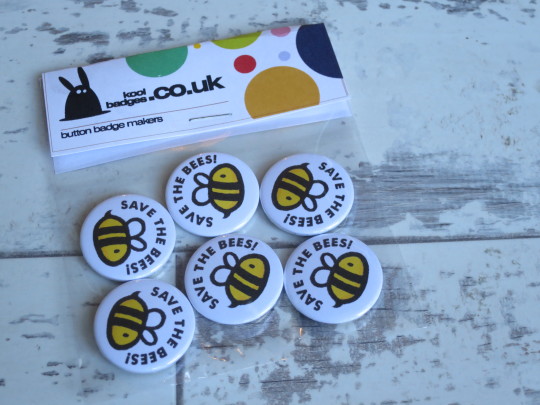


🐝 🌸 We have been busy making lots of cute badges for World Bee Day on May 20th 🍯 we have so many fun bumble bee themed designs to pick from 🌼
#worldbeeday#beekind#bee#bumblebee#honeybee#beebadges#insect#savethebees#badges#handmade#badgemaker#cutebadges#bbloggers#25mm#badge#craft#buttons#pins#koolbadges#bee buzzes#bumblebees#honey bee#bug#world bee day#bumble bee
5 notes
·
View notes